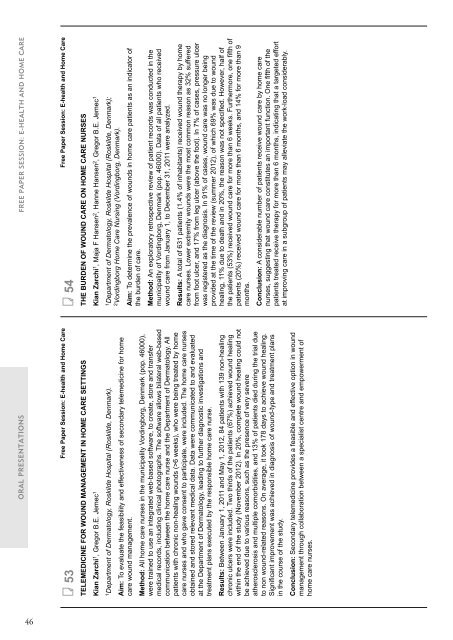Create successful ePaper yourself
Turn your PDF publications into a flip-book with our unique Google optimized e-Paper software.
ORAL PRESENTATIONS<br />
53<br />
Free Paper Session: E-health and Home Care<br />
TELEMEDICINE FOR WOUND MANAGEMENT IN HOME CARE SETTINGS<br />
Kian Zarchi 1 , Gregor B.E. Jemec 1<br />
1 Department of Dermatology, Roskilde Hospital (Roskilde, Denmark).<br />
Aim: To evaluate the feasibility and effectiveness of secondary telemedicine for home<br />
care wound management.<br />
Method: All home care nurses in the municipality Vordingborg, Denmark (pop. 46000),<br />
were trained to use an integrated web-based software, to create, store and transfer<br />
medical records, including clinical photographs. The software allows bilateral web-based<br />
communication between the home care nurse and the Department of Dermatology. All<br />
patients with chronic non-healing wounds (>6 weeks), who were being treated by home<br />
care nurses and who gave consent to participate, were included. The home care nurses<br />
obtained and stored relevant medical data. Data were communicated to and evaluated<br />
at the Department of Dermatology, leading to further diagnostic investigations and<br />
treatment plans executed by the responsible home care nurse.<br />
Results: Between January 1, 2011 and May 1, 2012, 84 patients with 139 non-healing<br />
chronic ulcers were included. Two thirds of the patients (67%) achieved wound healing<br />
within the end of the study (November 2012). In 20%, complete wound healing could not<br />
be achieved due to various reasons, such as the presence of very severe<br />
atherosclerosis and multiple comorbidities, and 13% of patients died during the trial due<br />
to non wound-related reasons. On average, it took 178 days to achieve wound healing.<br />
Significant improvement was achieved in diagnosis of wound-type and treatment plans<br />
in the course of the study.<br />
Conclusion: Secondary telemedicine provides a feasible and effective option in wound<br />
management through collaboration between a specialist centre and empowerment of<br />
home care nurses.<br />
FREE PAPER SESSION: E-HEALTH AND HOME CARE<br />
54<br />
THE BURDEN OF WOUND CARE ON HOME CARE NURSES<br />
Free Paper Session: E-health and Home Care<br />
Kian Zarchi 1 , Maja F Hansen 2 , Hanne Hansen 2 , Gregor B.E. Jemec 1<br />
1 Department of Dermatology, Roskilde Hospital (Roskilde, Denmark);<br />
2 Vordingborg Home Care Nursing (Vordingborg, Denmark).<br />
Aim: To determine the prevalence of wounds in home care patients as an indicator of<br />
the burden of care.<br />
Method: An exploratory retrospective review of patient records was conducted in the<br />
municipality of Vordingborg, Denmark (pop. 46000). Data of all patients who received<br />
wound care from January 1, to December 31, 2011 were analyzed.<br />
Results: A total of 631 patients (1.4% of inhabitants) received wound therapy by home<br />
care nurses. Lower extremity wounds were the most common reason as 32% suffered<br />
from foot ulcer, and 17% from leg ulcer (above the foot). In 7% of cases, pressure ulcer<br />
was registered as the diagnosis. In 91% of cases, wound care was no longer being<br />
provided at the time of the review (summer 2012), of which 69% was due to wound<br />
healing, 11% due to death and in 20%, the reason was not specified. However, half of<br />
the patients (53%) received wound care for more than 6 weeks. Furthermore, one fifth of<br />
patients (20%) received wound care for more than 6 months, and 14% for more than 9<br />
months.<br />
Conclusion: A considerable number of patients receive wound care by home care<br />
nurses, suggesting that wound care constitutes an important function. One fifth of the<br />
patients treated receive therapy for more than 6 months, indicating that a targeted effort<br />
at improving care in a subgroup of patients may alleviate the work-load considerably.<br />
46






